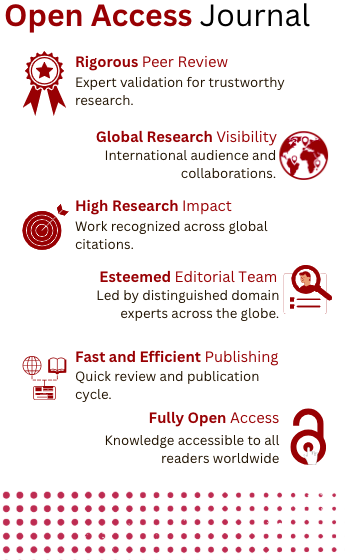Abnormal Event Detection and Signaling in Multiple Video Surveillance Scenes Using CNN
DOI:
https://doi.org/10.5281/zenodo.7937890Keywords:
Convolutional Neural Network, Abnormal Event, Pooling Layer, Classification, back propagationAbstract
Computer vision's key duty of abnormal situation identification has applications in surveillance, anomaly monitoring, and industrial inspection. This presentation offers a summary of the methods and developments in abnormal event detection with a particular emphasis on the application of Convolutional Neural Networks (CNNs). In a variety of computer vision applications, such as object detection and picture categorization, CNNs have achieved astounding success. CNNs have been widely used for abnormal event detection because of their capacity to extract hierarchical and spatial characteristics. CNN models may learn to distinguish between normal and abnormal patterns by being trained on huge datasets of typical occurrences. This allows for efficient anomaly identification. The effectiveness of CNN-based abnormal event detection has been greatly enhanced via transfer learning. For specialized abnormal event detection applications, pre-trained CNN models, like those trained on ImageNet, offer a foundation of learnt characteristics that may be fine-tuned. The model's capacity to generalize to new datasets and previously undiscovered anomalies is improved by this transfer of information.References
Lu, C., Shi, J., & Jia, J. (2013). Abnormal event detection at 150 fps in matlab. In Proceedings of the IEEE international conference on computer vision (pp. 2720-2727).
Del Giorno, A., Bagnell, J. A., & Hebert, M. (2016). A discriminative framework for anomaly detection in large videos. In Computer Vision–ECCV 2016: 14th European Conference, Amsterdam, The Netherlands, October 11-14, 2016, Proceedings, Part V 14 (pp. 334-349). Springer International Publishing.
Atghaei, A., Ziaeinejad, S., & Rahmati, M. (2020). Abnormal event detection in urban surveillance videos using GAN and transfer learning. arXiv preprint arXiv:2011.09619.
Ma, Q. (2021). Abnormal Event Detection in Videos Based on Deep Neural Networks. Scientific Programming, 2021, 1-8.
Javan Roshtkhari, M., & Levine, M. D. (2013). Online dominant and anomalous behavior detection in videos. In Proceedings of the IEEE conference on computer vision and pattern recognition (pp. 2611-2618).
Ramachandra, B., & Jones, M. (2020). Street scene: A new dataset and evaluation protocol for video anomaly detection. In Proceedings of the IEEE/CVF Winter Conference on Applications of Computer Vision (pp. 2569-2578).
Sultani, W., Chen, C., & Shah, M. (2018). Real-world anomaly detection in surveillance videos. In Proceedings of the IEEE conference on computer vision and pattern recognition (pp. 6479-6488).
Madhusudhan, M. V., Udaya Rani, V., & Hegde, C. (2021). Finger vein recognition model for biometric authentication using intelligent deep learning. International Journal of Image and Graphics, 2240004.
Herzig, R., Levi, E., Xu, H., Gao, H., Brosh, E., Wang, X., ... & Darrell, T. (2019). Spatio-temporal action graph networks. In Proceedings of the IEEE/CVF international conference on computer vision workshops.
Haresh, S., Kumar, S., Zia, M. Z., & Tran, Q. H. (2020, October). Towards anomaly detection in dashcam videos. In 2020 IEEE Intelligent Vehicles Symposium (IV) (pp. 1407-1414). IEEE.
Chattoraj, M., & Vinayakamurthy, U. R. (2021). A self adaptive new crossover operator to improve the efficiency of the genetic algorithm to find the shortest path. Indonesian Journal of Electrical Engineering and Computer Science, 23(2), 1011-1011.
Al-Shammari, N. K., Alzamil, A. A., Albadarn, M., Ahmed, S. A., Syed, M. B., Alshammari, A. S., & Gabr, A. M. (2021). Cardiac stroke prediction framework using hybrid optimization algorithm under DNN. Engineering, Technology & Applied Science Research, 11(4), 7436-7441.
Sreedhar Kumar, S., Ahmed, S. T., Mercy Flora, P., Hemanth, L. S., Aishwarya, J., GopalNaik, R., & Fathima, A. (2021, January). An Improved Approach of Unstructured Text Document Classification Using Predetermined Text Model and Probability Technique. In ICASISET 2020: Proceedings of the First International Conference on Advanced Scientific Innovation in Science, Engineering and Technology, ICASISET 2020, 16-17 May 2020, Chennai, India (p. 378). European Alliance for Innovation.
Morais, R., Le, V., Tran, T., Saha, B., Mansour, M., & Venkatesh, S. (2019). Learning regularity in skeleton trajectories for anomaly detection in videos. In Proceedings of the IEEE/CVF conference on computer vision and pattern recognition (pp. 11996-12004).
Ahmed, S., Guptha, N., Fathima, A., & Ashwini, S. (2021, January). Multi-View Feature Clustering Technique for Detection and Classification of Human Actions. In Proceedings of the First International Conference on Advanced Scientific Innovation in Science, Engineering and Technology, ICASISET 2020, 16-17 May 2020, Chennai, India.
Bhat, A., Bhanuranjan, S. B., Narayan, K. L., & Lavanya, N. L. (2023). Survey On Object Detection, Face Tracking, Digital Mapping and Lane Following For Remotely Piloted Aerial Systems (RPAS). International Journal of Human Computations & Intelligence, 2(2), 94-105.
Downloads
Published
How to Cite
Issue
Section
License
Copyright (c) 2023 Neetu Vijayananda, Lavanya N L, Nidhi N Sattigeri, Nisarga R K, Pooja N M

This work is licensed under a Creative Commons Attribution-NonCommercial-NoDerivatives 4.0 International License.







